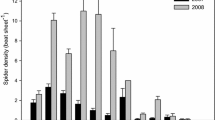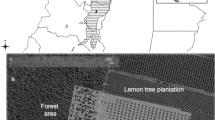Abstract
Evaluation of the landscape-level movement of Stenotus rubrovittatus (Matsumura), a major rice pest in Japan, is essential for establishing management strategies. We assessed the immigration timing and the average dispersal distance from a bank slope covered with Italian ryegrass Lolium multiflorum Lam. to paddy fields by periodic sampling in two regions in Chiba Prefecture. The immigrant densities in paddy fields increased exponentially as they approached the bank slope as a large-scale habitat of the insect. The relationship between immigrant density and distance from the source habitat fit an empirical model and theoretical model well. The theoretical model estimated the average dispersal distance during immigration: that of females was 72.0 and 92.1 m and that of males was 122.0 and 112.9 m in the respective regions. In addition, the average dispersal distance of males increased 7 days or later after the rice heading date despite the steady dispersal distance of females.






Similar content being viewed by others
References
Boivin G, Stewart RK (1983) Seasonal development and interplant movements of Phytophagous Mirids (Hemiptera: Miridae) on alternate host plants in and around an apple orchard. Ann Entomol Soc Am 76:776–780
Bolker B (2012) bbmle: Tools for general maximum likelihood estimation. R package version 1.0.5.2
Busching MK, Turpin FT (1976) Oviposition preferences of black cutworm moths among various crop plants, weeds, and plant debris. J Econ Entomol 69:587–590
Cleveland TC (1982) Hibernation and host plant sequence studies of tarnished plant bugs, Lygus lineolaris, in the Mississippi delta. Environ Entomol 11:1049–1052
Coaker TH (1987) Cultural method: the crop. In: Burn AJ, Coaker TH, Jepson PC (eds) Integrated pest management. Academic press, London, pp 79–80
ESRI (2004) ArcGIS version 9.2. Environmental Systems Research Institute, Redlands
Fleischer SJ, Gaylor MJ, Hue NV (1988) Dispersal of Lygus lineolaris (Heteroptera: Miridae) adults through cotton following nursery host destruction. Environ Entomol 17:533–541
Goto J, Ito Y, Shishido M (2000) Relationship between barn grass in rice paddies and spotted rice caused by Stenotus rubrovittatus (Matsumura). Ann Rept Plant Prot North Jpn 51:62–164 (in Japanese)
Hayashi H (1986) Ecology and control of the sorghum plant bug (Stenotus rubrovittatus Matsumura) causing the pecky rice. Plant Prot 40:21–326 (in Japanese)
Hayashi H, Nakazawa K (1988) Studies on the bionomics and control of the sorghum plant bug, Stenotus rubrovittatus Matsumura (Hemiptera: Miridae) 1. Habitat and seasonal prevalence in Hiroshima prefecture. Bull Hiroshima Agric Exp Stn 51:45–53 (in Japanese with English summary)
Higuchi H (2010) Ecology and management of rice bugs causing pecky rice. Jpn J Appl Entomol Zool 54:171–188. doi:10.1303/jjaez.2010.171 (in Japanese)
Horton DR, Capinera JL, Chapman PL (1988) Local differences in host use by two populations of the Colorado potato beetle. Ecology 69:823–831
Ichimori T, Chiba T, Tanaka H et al (1990) Relation between the content of spotted rice and the distance from the origin place of sorghum plant bug, Stenotus rubrovittatus Matsumura. Ann Rept Plant Prot North Jpn 41:121–124 (in Japanese)
Irwin ME (1999) Implications of movement in developing and deploying integrated pest management strategies. Agric For Meteorol 97:235–248. doi:10.1016/S0168-1923(99)00069-6
Ito K (2004) A possible cause of recent outbreaks of rice-ear bugs-changes in the use of paddy field. Ann Rept Plant Prot North Jpn 55:134–137 (in Japanese)
Kashin J, Hatanaka N, Ono T et al (2009) Effect of Scirpus juncoides Roxb. var. ohwianus on occurrence of sorghum plant bug, Stenotus rubrovittatus (Matsumura) (Hemiptera: Miridae) and pecky rice. Jpn J Appl Entomol Zool 53:7–12. doi:10.1303/jjaez.2009.7 (in Japanese with English abstract)
Katase M, Shimizu K, Siina S et al (2007) Seasonal occurrence of rice bugs in the northern part of Chiba prefecture. Ann Rept Kanto Pl Prot Soc 54:99–104 (in Japanese)
Kikuchi A, Kanno H, Kimura T et al (2004) A survey on the occurrence of rice-ear bugs and their damage in the Tohoku region from 1999 to 2002. Bull Natl Agric Res Cent Tohoku Reg 102:101–180 (in Japanese with English abstract)
Kobayashi T (2007) Flight velocity of rice leaf bug, Trigonotylus caelestialium and sorghum plant bug, Stenotus rubrovittatus (Heteroptera: Miridae). Ann Rept Plant Prot North Jpn 58:96–98 (in Japanese with English abstract)
Nakata K (2000) Occurrence trend of the sorghum plant bug, Stenotus rubrovittatus Matsumura, in grass and rice fields. Plant Prot 54:316–321 (in Japanese)
Negron JF, Riley TJ (1991) Seasonal migration and overwintering of the chinch bug (Hemiptera: Lygaeidae) in Louisiana. J Econ Entomol 84:1681–1685
Niiyama T (2000) Outbreak of rice leaf bug, Trigonotylus caelestialium (Kirkaldy) in 1999. Plant Prot 54:309–312 (in Japanese)
Norris RF, Kogan M (2000) Interactions between weeds, arthropod pests, and their natural enemies in managed ecosystems. Weed Sci 48:94–158
Ono T, Kashin J, Kidokoro T (2007) Control of sorghum plant bug, Stenotus rubrovittatus (Matsumura) (Hemiptera: Miridae), in rice paddy field by grass mowing in relation to migration source. Ann Rept Plant Prot North Jpn 58:75–79 (in Japanese)
Panizzi AR (1992) Performance of Piezodorus guildinii on four species of Indigofera legumes. Entomol Exp Appl 63:221–228
Takada M, Tanaka H, Chiba T (2000) Occurrence of the spotted rice in Iwate prefecture in 1999. Ann Rept Plant Prot North Jpn 51:165–169 (in Japanese)
Takeda A, Shimizu K (2009) Characteristics of the damaged grain caused by the sorghum plant bug, Stenotus rubrovittatus (Hemiptera: Miridae) at different infection periods. Ann Rept Kanto Pl Prot Soc 56:85–87 (in Japanese)
Takeda A, Shimizu K, Shiina S et al (2008) Seasonal prevalence of Stenotus rubrovittatus (Hemiptera: Miridae) in a gramineous weed field and a rice field. Ann Rept Kanto Pl Prot Soc 55:97–102 (in Japanese)
Takeda A, Yasuda M, Tabuchi K et al (2011) Effects of gramineous weed control on the seasonal occurrence of rice bugs in the northern part of Chiba prefecture. CAFRC Res Bull 3:79–84 (in Japanese with English abstract)
Taylor RAJ (1978) The relationship between density and distance of dispersing insects. Ecol Entom 3:63–70. doi:10.1111/j.1365-2311.1978.tb00903.x
Teramoto N (2003) Control of rice sting bug complex (Hemiptera) in paddy fields by gramineous weed control on balks. Bull Shiga Agric Res Cent Exp Stn 43:47–70 (in Japanese with English summary)
Turchin P, Omland KS (1999) Quantitative analysis of insect movement. In: Huffaker CB, Gutierrez AP (eds) Ecological entomology. Wiley, New York, pp 479–488
Wallace B (1966) On the dispersal of Drosophila. Am Nat 100:551–563
Watanabe T, Higuchi H (2006) Recent occurrence and problem of rice bugs. Plant Prot 60:201–203 (in Japanese)
Yamamura K, Kishita M, Arakaki N et al (2003) Estimation of dispersal distance by mark-recapture experiments using traps: correction of bias caused by the artificial removal by traps. Popul Ecol 43:149–155. doi:10.1007/s10144-003-0152-x
Yasuda M (2012) Does surrounding landscape composition affect agricultural pest abundances? Plant Prot 66:366–370 (in Japanese)
Yasuda M, Mitsunaga T, Takeda A et al (2011) Comparison of the effects of landscape composition on two mirid species in Japanese rice paddies. Appl Entomol Zool 46:519–525. doi:10.1007/s13355-011-0071-9
Yoshioka A, Takada M, Washitani I (2011) Facilitation of a native pest of rice, Stenotus rubrovittatus (Hemiptera: Miridae), by the non-native Lolium multiflorum (Cyperales: Poaceae) in an agricultural landscape. Environ Entomol 40:1027–1035. doi:10.1603/EN11032
Yuasa K (2006) Relationships between weeds on levee of paddy fields and incidence of the rice sting bugs and pecky rice. Plant Prot 60:211–214 (in Japanese)
Acknowledgments
We thank the owners of the paddies and the staff of the Katori Agriculture Office. We also thank Dr. Yamamura for explaining the dispersal model. This study was supported by a Grant-in-Aid for Research Projects Utilizing Advanced Technologies in Agriculture, Forestry and Fisheries from the Ministry of Agriculture, Forestry and Fisheries of Japan.
Author information
Authors and Affiliations
Corresponding author
Rights and permissions
About this article
Cite this article
Takeda, A., Yasuda, M., Tabuchi, K. et al. Pattern of immigration of the sorghum plant bug Stenotus rubrovittatus (Hemiptera: Miridae) into paddy fields from a large source habitat. Appl Entomol Zool 49, 139–147 (2014). https://doi.org/10.1007/s13355-013-0233-z
Received:
Accepted:
Published:
Issue Date:
DOI: https://doi.org/10.1007/s13355-013-0233-z




